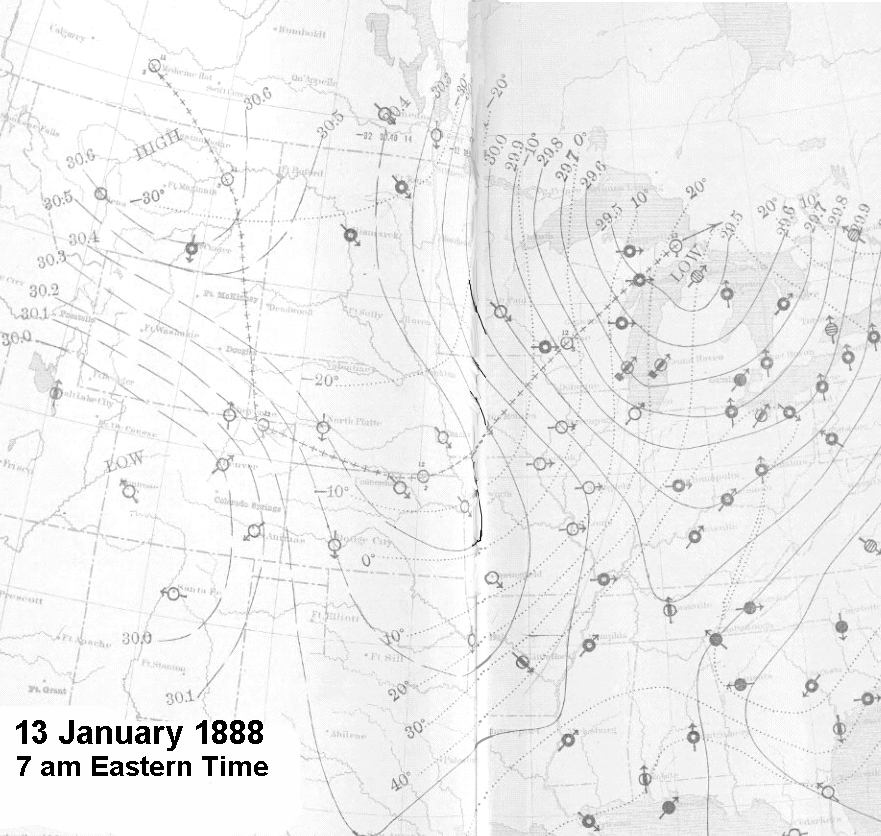01.14.11
The Children’s Blizzard of 1888
On January 12, 1888, an arctic cold front swept through the Great Plains, bringing temperature drops from the upper 30s to minus 20 °F (minus 40 °F in the Northern Plains), strong winds, and heavy snow.
Thousands of people were caught out in the cold and snow, as the blizzard was very sudden, it struck during work and school hours, and many people were outside as the temperatures leading up to the passage of the front were fairly mild. At least 235 people died in the storm, many of them children in the Dakotas and Nebraska, walking home in the blizzard and/or freezing in the arctic temperatures (hence the name “Schoolhouse Blizzard” or “Children’s Blizzard”).
Map of temperatures and pressure on the morning after the blizzard. Click to enlarge. Source: Wikipedia
My grandmother’s grandparents, father, and aunts and uncles got to experience this blizzard from southwest Iowa. Here is the story as she heard it from her father (Julius), some 70 years ago.
Written by Izetta (Kiersch) LaBar:
———————-
BLIZZARD OF JANUARY 12, 1888
The day dawned slightly cloudy, uneventful, and just like all the other January days had been. A foot of snow lay on level places, and the temperature was warm enough to make good snowballs. Frank, Dora, and Charley were through school and at home; also at home, because they were too young to attend school, were John, Agnes, and Harry. Those who attended school that day were Julius and Bertha. At that time the teacher was boarding with the Kierschs.
The day went as usual, with the dismissal at 4 and the sky still somewhat cloudy. The two children and the teacher started home across the field, following an old oxen trail which was already rutted too deep to use in four trails, though a fifth trail was still being used. They dallied along, snowballing as they went, until at about 4:30 the perfect calm of the day was suddenly broken. Without any warning a blizzard was upon them, and they were only halfway home. The gale was so strong they could hardly stand; yet they had to go on. They must keep moving. The teacher kept her head and marched straight west to a fence that they knew very well – it must be there to guide them if they could find it. Straight, straight west, and they reached the fence at last. Now the problem was to follow it south to another fence, which would lead them home. How could they keep their sense of direction so well, did they worry for fear they might be going the wrong way? Who knew what their thoughts were? The snow was soon two feet deeper, but follow the fence they must to the south end of it. At last here was the east and west fence along the familiar county line road; now to follow it west for home. Being worn into a depression the road was already drifted full.
They floundered through the deep snow step by step, and were unable to take one more step when at last they reached the door. There they found mother and Dora in tears, worrying and wailing about the fate that must have overtaken the two children. Such a relief! There was a bustle of removing thoroughly soaked clothing, warming the three up, and finding dry clothing for them. In the midst of the flurry, father stomped in covered from head to foot with blizzard snow. He had survived the two-mile fight along the railroad track from Bill Boehm’s, where he had gone earlier in the day to make a cutter with his neighbor’s help. Even a man of his strength had had his worries too, fighting the icy blasts. His first words, after barely having entered the door were: “Sind die Kinder Heim?” (Are the children home?)
The blizzard blew for three days, making drifts up to the eaves of the house on the south side. The cattle sheds were covered with snow, and the inside was full too, except for in a small spot where the cattle had milled around, and now were standing with their heads and hair all full of snow and ice. Drifts of snow all over the place were so solid, the cattle could walk right over all of the fences.
The trains didn’t come through for a week, but when the snowplow finally showed up it had three locomotives. They got stuck in the cut west of the house, and had to shovel to get backward to make a long run for this six or eight foot drift. Julius, Frank, and August Fieselman were standing above on the bank watching. When they finally got themselves shook off, dug out, and eyes wiped the engines were two miles up the track!
———————-
